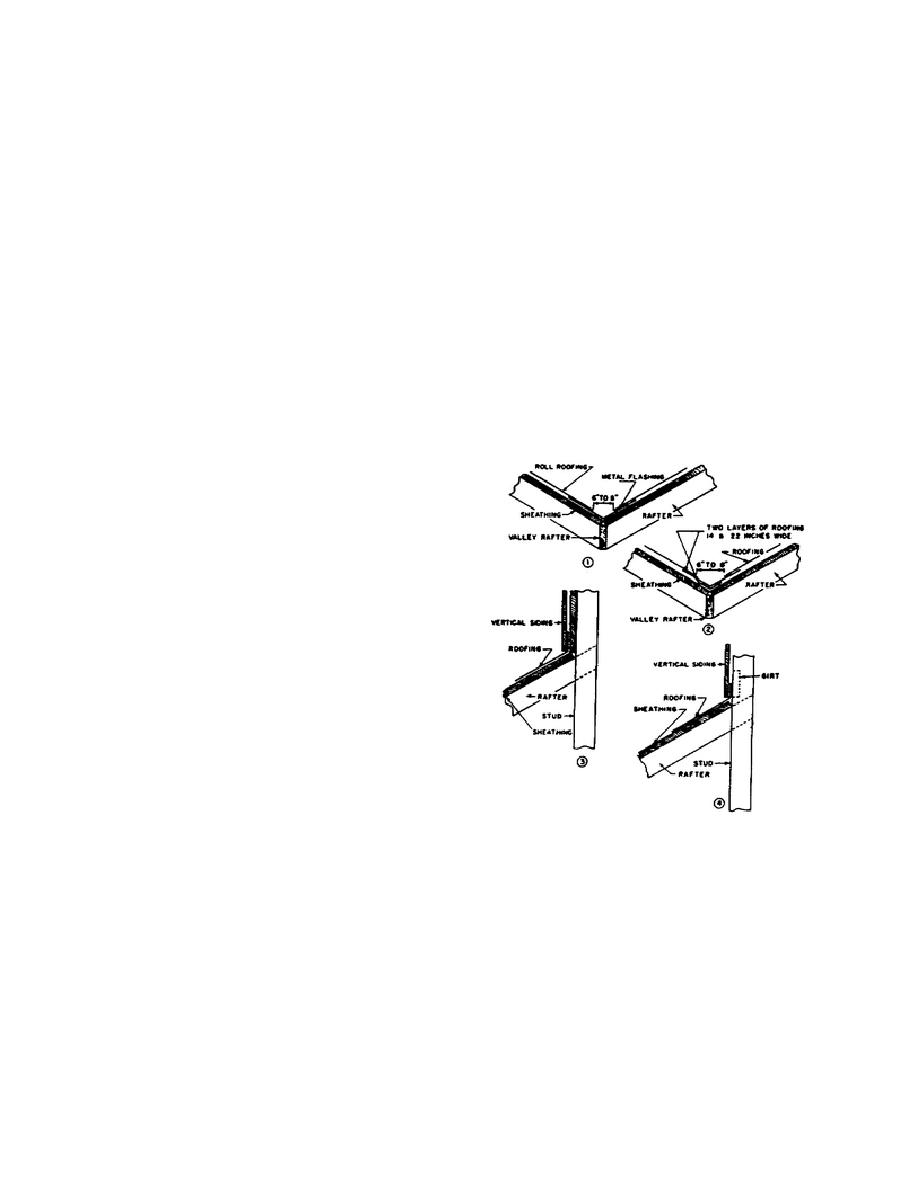
This type of roofing is furnished in rolls and is
3-6.
ROOF FLASHINGS
sometimes called "roll roofings." TO structures are
Where two roofs come together at angles, a
normally roofed with a paper weighing 40 pounds per
valley is formed and some type of additional
roll; for wall coverings a 15-pound asphalt felt is
covering must be used along the joint to provide
standard.
adequate waterproofing. A hasty and yet satisfactory
expedient is to use two layers of roll roofing in the
3-5.
ROOFING INSTALLATION
valley, one 14 inches and the other 22 inches wide,
a. Corrugated roofing. Corrugated sheet
both cut from a 36-inch width of material. A strip of
iron may be nailed to either solid or slatted wood
sheet metal 22 inches wide may also be used (1 and
sheathing, or to wood purlins. The sheets are
2, fig. 3-3;). The metal or roll-roofing material used
overlapped one or two corrugations on the sides and
to cover the joining roofs is cut back from the center
6 or 8 inches on the ends, depending upon the slope
of the valley 3 or 4 inches, as shown in 1 and 2, fig.
of the roof. To nail this type of roofing securely, a
3-3. The joint formed when a roof butts against a
special type nail should be used, such as lead-headed
vertical wall is flashed as seen in 3 and 4, fig. 3-3.
nail or a galvanized nail with a neoprene washer.
Metal or roll roofing may be used as the flashing. If
Common wire nails may be used but they rust easily
the vertical wall is not sheathed, a girt is installed
and may cause slight leaks. The side laps should be
between the studs (4, fig. 3-3), to support the
nailed every 2 feet, while the end laps should be
flashing.
nailed every foot. This type of roofing should not be
used on roofs with slopes of less than 4 inches per
foot.
b. Prepared roofing. Prepared roofing is
nailed to solidly sheathed roofs with special nails and
asphaltic material that are normally furnished with
the roofing. These nails have large, flat heads and
are used on edge and end laps 3 inches on centers.
All laps are cemented with asphalt or tar before being
nailed. Prepared roofing may be laid parallel to the
roof slope, but it is somewhat less likely to leak when
the strips run parallel to the eaves.
In TO
construction this type of roofing should be laid with
an -inch end lap and with a 4-inch edge or side lap on
slopes of more than 2 inches per foot. If used on
flatter slopes, at least a 6-inch edge lap must be used
and great care must be taken to have all joints fully
cemented. All roof slopes of less than 1 inch per foot
are unsuitable for prepared roofing and require
multilayer, built-up roofing. Because of the wide
laps used by the Army and allowances for jobcut
flashings, a 40-pound roll (or "square ") of
prepared roofing will cover only 80 square feet in
Figure 3-3. Flashing details.
TO construction. Rolls of 15- and 30-pound felt
3-7.
HOOD
cover 320 and- 160 square feet, respectively.
The hood or canopy is used in tropical climates
to afford protection to the screened opening at the
ends of the buildings. Hoods are framed to the end
walls with short rafters which are nailed to the
building with knee braces, as shown in figure 3-4.
The rafters
3-3


 Previous Page
Previous Page
